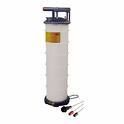This may be kind of OT, however it could also cross over to be useful in the machine world. I have one of those small hand held vacuum pumps for removing fluids from things, like power steering fluid, coolant in automobile type applications for the most part. I want to build one with a electric motor, some different size fitting/hose fittings, and it will be used a lot if it turns out that it works for changing oil, coolant, etc as a maintenance item. I have no idea where to start, what type of motor would I need for this, HP, also type of pump as it will need to be self priming I'm sure. I have a Little Giant magnetic drive ($800 job), however it is not self priming, and is way to big for this application.
I also know they sell them however I need a project, and would like to scrounge this one if I can. I have a Lathe, no mill, I'm thinking of making the adapter/fittings myself for different pipe/hose sizes, I will need to put together the motor, and pump from purchased or scrounged items. I'm thinking ebay, surplus etc, but need some helpful suggestions on what to start looking for.
Clint
I also know they sell them however I need a project, and would like to scrounge this one if I can. I have a Lathe, no mill, I'm thinking of making the adapter/fittings myself for different pipe/hose sizes, I will need to put together the motor, and pump from purchased or scrounged items. I'm thinking ebay, surplus etc, but need some helpful suggestions on what to start looking for.
Clint
.png)
 I have a 12 volt waste oil pump made specifically for marine engines. Since I got the "oil sucker" in the attached photo the 12 volt unit has become obsolete. At the risk of starting a whole new "discussion" I don't agree with the comment that a vacuum pump will leave sludge. This may be true in an industrial environment but I have not seen any evidence to support that in a marine/automotive application. I have worked in the marine industry since 1985 and have done literally thousands of oil changes with a vacuum pump. Maybe in an engine that has been neglected or not run up to full operating temperature prior to changing the oil. If the sludge is that sticky that a vacuum pump won't pick it up I doubt it would flow out the drain hole in the pan. I have seen more sludge up in valve covers than in oil pans.
I have a 12 volt waste oil pump made specifically for marine engines. Since I got the "oil sucker" in the attached photo the 12 volt unit has become obsolete. At the risk of starting a whole new "discussion" I don't agree with the comment that a vacuum pump will leave sludge. This may be true in an industrial environment but I have not seen any evidence to support that in a marine/automotive application. I have worked in the marine industry since 1985 and have done literally thousands of oil changes with a vacuum pump. Maybe in an engine that has been neglected or not run up to full operating temperature prior to changing the oil. If the sludge is that sticky that a vacuum pump won't pick it up I doubt it would flow out the drain hole in the pan. I have seen more sludge up in valve covers than in oil pans.




 Rick
Rick
Comment